Electricity and other types of energy can be produced directly from the sun, even in cloudy weather. Solar energy is used worldwide and is increasingly popular for generating electricity or also for heating and desalinating water. Solar power can be generated in two main ways:
- Photovoltaics (PV) or solar cells are semiconductor devices that convert sunlight directly into electricity. The modern solar cells are likely an image most people would recognise – they are in the panels installed on fields, houses and in calculators. They were invented in 1954 at Bell Telephone Laboratories in the United States. Today, solar PV is one of the fastest-growing renewable energy technologies, and is ready to play a major role in the future global electricity generation mix. Solar PV installations can be combined to provide electricity on a commercial scale, or arranged in smaller configurations for mini-grids or personal use. Using solar PV to power mini-grids is an effective way to bring electricity access to people who do not live near power transmission lines. The cost of manufacturing solar panels has plummeted dramatically in the last decade, making them not only affordable but often the cheapest form of electricity. Solar panels have a lifespan of roughly 30 years depending on the type of material used in manufacturing.
- Concentrated solar power (CSP), uses mirrors to concentrate solar rays. These rays heat fluid, which creates steam to drive a turbine and generate electricity. CSP is used to generate electricity in large-scale power plants. A CSP power plant usually features a field of mirrors that redirect rays to a tall thin tower. One of the main advantages of a CSP power plant over a solar PV power plant is that it can be equipped with molten salts in which heat can be stored, allowing electricity to be generated after the sun has set.
Solar energy is one of the most promising and dynamic renewable energy sources. Each year, the capacity increase put into operation is approximately 40-50%. In the last fifteen years, the share of solar electricity in the world has exceeded 5%. Improvement in the technology of manufacturing photovoltaic modules has led to a significant reduction in the cost of electricity. In more than 30 countries (including Germany, Chile, Australia, Mexico), solar energy has become cheaper than traditional sources (oil, gas, coal). Over the past 10 years, investments in solar energy have amounted to about $ 300 billion. The most illustrative example of the solar technology success is Tau Island (American Samoa). Previously, the islanders were completely dependent on the supply of diesel, but after the installation of a modern solar power plant they became completely independent.
Ukraine is taking important steps to increase the use of renewable energy sources and alternative fuels as part of its broader strategy to reduce dependence on traditional fossil fuels. It is estimated that our country has the potential to increase renewable energy tenfold by 2030 and reduce natural gas consumption by 15%.
It is worth noting that the climate and geographical location of Ukraine are favorable for the development of solar energy and the construction of solar power plant. Even the northern regions of the country have considerable potential for the development of this industry, which is not yield to most European regions.
Currently, the development of solar energy in Ukraine is at a stage that Europe has undergone 7-10 years ago. At the same time, we have one of the most attractive investment structures in Europe for the development of the industry. Indeed, favorable conditions have been created here: availability of resources and land, a preferential tariff, state support and a targeted energy strategy that aims to reach 25% of the clean energy production by 2035. As a result, the interest to renewable energy in Ukraine continues to grow, and the government estimates that by 2020, total investment in alternative energy will reach US $ 18 billion.
Although the renewable energy sources sector is still small in comparison to other types of generation in Ukraine, but at the same time shows the steady growth, making our country a leader in this sector. From 2014 to the end of 2017, the capacity of renewable energy sources has increased from 967 to 1375 MW and till the end of the 1st quarter 2018 to 1534 MW (Fig. 1). How exactly the renewable energy sources are distributed by region and what kind of renewable energy sources prevails in a particular region can be seen in Fig. 2.
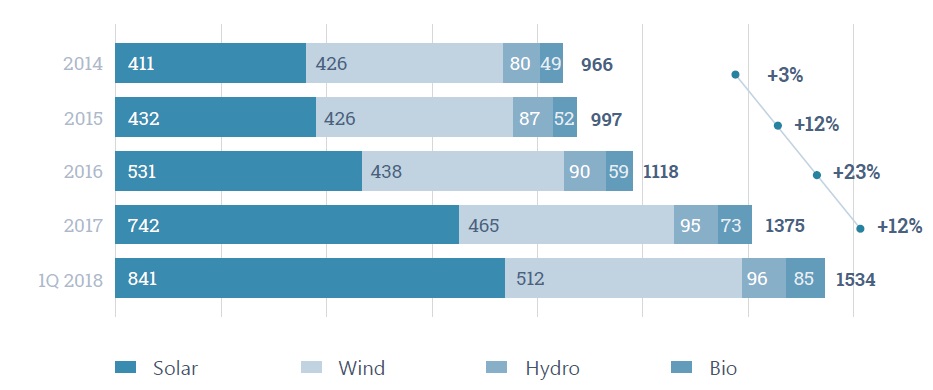
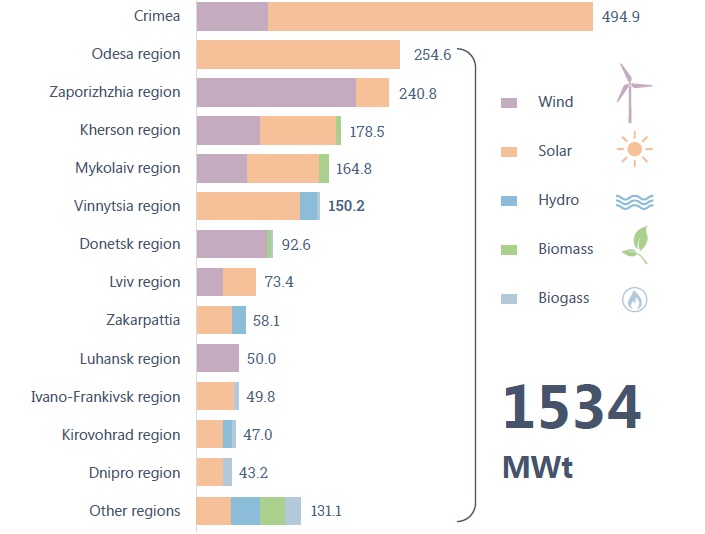
As solar energy is a very popular renewable energy source in Ukraine, it can be observed that the regional distribution of installed RES correlates with the level of insolation. The focus is on the regions with the highest solar activity, as shown in the map below (Fig. 3).

The question of the solar modules performance is one of the first that people ask when planning to invest in solar power. The amount of electricity that will be produced with the help of the solar module depends on many factors, including the geographical location of the solar power plant. At all other things being equal the amount of electricity produced is direct proportional to the amount of solar radiation reaching the earth’s surface at the solar power plant location.
Solar energy is one of the environmentally sustainable resources for producing electricity using photovoltaic (PV) systems. The main input data used in the planning process is solar radiation. Photovoltaic Geographical Information System (PVGIS) has developed a solar radiation database from climatologic data homogenized for Europe and available in the European Solar Radiation Atlas. The model algorithm estimates beam, diffuse and reflected components of the clear-sky and real-sky global irradiance/irradiation on horizontal or inclined surfaces.
PVGIS periodically publishes posters and maps of solar electric potential. This information is very detailed. Below you will find current data visualization for photovoltaic solar potential in Ukraine and Europe. These maps are published on 21th of September 2012. The map above shows the distribution of the global solar irradiation and the solar electric potential on the territory of Ukraine in the case of the orientation of solar modules to the south at the optimal angle (the most perpendicularly to the sun’s rays). To compare, please, see also another one with PV solar electricity potential in European countries:
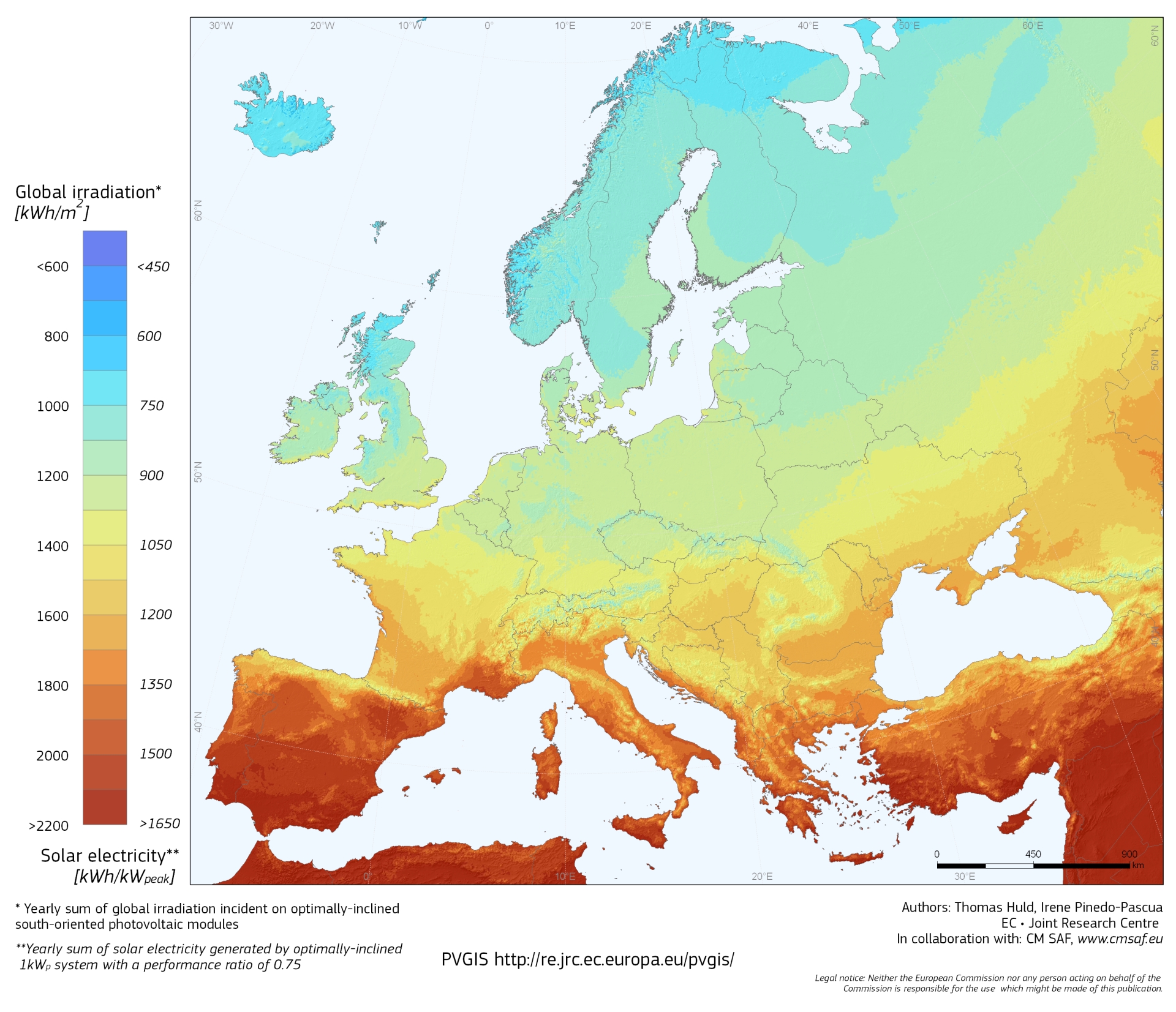
According to forecasts, by 2020 the capacity of installed solar energy facilities in Ukraine will increase to 3 GW. As of April 1, 2019, more than 2.2 GW of solar energy facilities have been installed in the country, which make 71% of all existing RES. Such rapid and active development of the industry has allowed Ukraine to rise from 34th to 23rd place in the global solar energy rating.
In the future, Ukraine can take on the successful experience of our foreign counterparts to enhance the prospects for solar energy.
- Transportation opportunities. Everybody knows and even sees many modern electric cars on the roads of our country’s metropolises, but few people know that in European countries photovoltaic cells are placed on the roofs of trains and provide them with electricity during operation. In the long term, this technology can be applied to both water and aircraft.
- Thermal energy – a way of converting the sun’s energy by heating water in containers that are well conductive.
In general, solar power will increase capacity in Ukraine because:
- there is an interest of foreign investors;
- there are many regions in the country where the solar power station equipment is operating as efficiently as possible;
- long-term profit is guaranteed after the one-time investment.
Why is it promising to build solar power plants?
- Solar energy and energy saving is a worldwide trend. The year 2017 was significant for solar photovoltaics – compared to other types of power generation technology, solar power appeared the largest commissioning source of energy. The five largest national markets – China, the USA, India, Japan and Turkey – account for almost 84% of the newly installed capacity. This is followed by Germany, Australia, the Republic of Korea, the United Kingdom and Brazil. China, the USA, Japan, Germany, Italy and India are leading in aggregate capacity (Fig. 4-5).
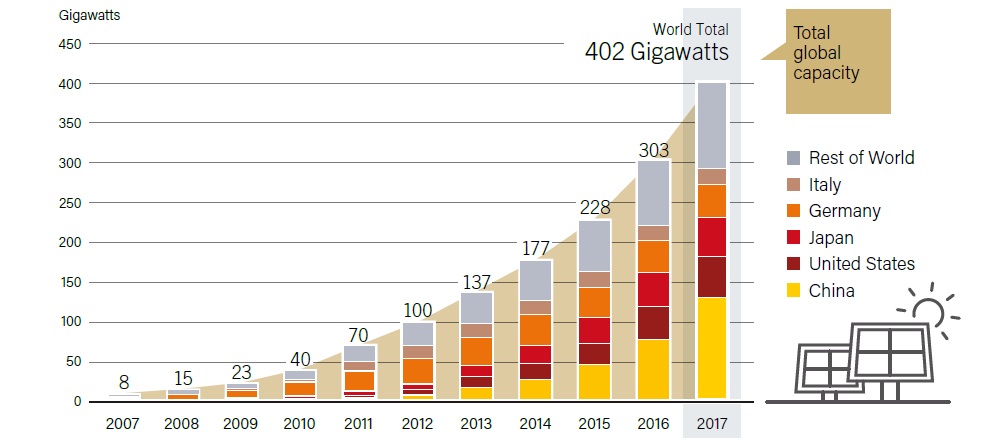
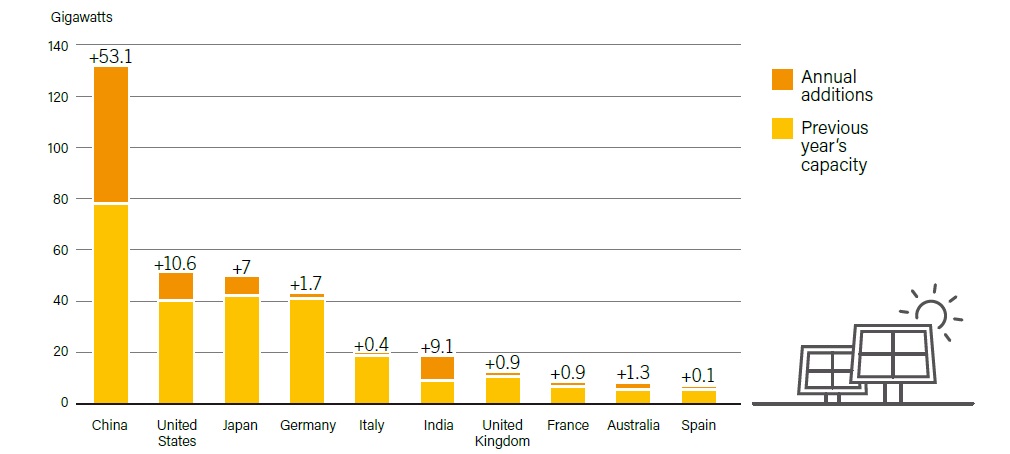
- Quite illustrative example of solar technology development is China, which has become the world leader in solar power in just five years as an outsider in the market. During 2016-2020, China is investing about $ 145 billion in the construction of solar power stations – this will enable the commissioning of about 1,000 powerful stations. China has long become the industry leader in solar panels and hardware. China controls 70% of the world’s solar panels and is leading the way in solar usage.
It is expected that by 2040 China will provide 28% of all investment in electricity generation.
- According to experts, by 2070, solar energy will be the main source of electricity on Earth, and by the beginning of the next century, solar energy will be 3.5 times higher than the oil industry and 6 times- nuclear power by the beginning of the next century.
- Solar energy is virtually inexhaustible, and is also a completely free resource.
- Modern technologies allow solar panels to be obtained which, with minimum operating costs and maintenance, will ensure efficient generation of electricity for at least 30 years.
- Analysts predict that global solar prices will decrease on average 27% during 2017 and 2022. Utility-scale solar installations will cost less than coal-fired power plants in all developed countries. Indeed, in many places around the world (including some in the USA) solar energy has already reached parity, ie the cost of solar energy is equal or lower than the cost of purchasing energy from the grid.
Why is the popularity of solar power plants increasing in Ukraine?
- Favorable climate – the level of insolation (that is, the amount of solar radiation per square meter of Earth’s surface) in most regions of Ukraine exceeds Germany ones, which is one of the world leaders in the field of solar energy.
- A favorable legal framework that really stimulates investment in alternative energy, the green tariff according to which the state buys all electricity produced by the solar power plants is one of the highest in Europe. In April 2019, a law on green auctions was approved. According to it, participation in the auctions will be compulsory from 2020 for solar power projects with a capacity of more than 1 MW and wind power plants with a capacity of more than 5 MW. In terms of the auction, the one who offers the lowest price will be able to sell the “clean” electricity to the state. The auction is designed to prevent monopoly in the Ukrainian renewable energy sources market. It should be a transparent competition held through the ProZorro e-commerce system twice a year, in autumn and spring.
- Opportunities to invest in the Ukrainian alternative energy sector are extremely favorable, as the country has a diverse supply of materials and a well-educated workforce that has the technical know-how necessary to develop and implement the latest commercial developments in the sector.
- The constant increase in the cost of electricity makes it justified to invest in generating its own electricity. Speaking about the cost, we can already announce the price parity between alternative and traditional electricity.
The benefits of solar power plants for your business
- Cost Reduction – the cost of solar electricity now is lower than electricity tariffs on the grid.
- Energy independence of production (business) and the formation of a positive image of an innovative, socially responsible company around society and potential customers.
- The payback period of investment, depending on the type and capacity of the solar power station, is 5-7 years, for private (domestic) solar power plants – up to 10 years.
- Low operating costs – minimum staff number due to high automation and low maintenance costs.
- Reduced operating costs / energy savings – the solar energy system can reduce or even eliminate the electricity bill for your business.
- Technology development – technologies in the solar energy industry are constantly evolving and improvements will be accelerated in the future. Innovations in quantum physics and nanotechnology can potentially increase the efficiency of solar panels and double or even triple the electrical power of solar energy systems.
Avenston is one of the leaders of solar energy in Ukraine and the recognized expert in the field of project management and construction of solar power plants. Our company has the great practical experience and offers collaboration in turnkey project management in the renewable energy sources field. It means that we will provide consulting and full construction and maintenance service for solar power plants, including technical, financial, legal and formal aspects.